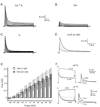Tetraethylammonium (TEA) increases the inactivation time constant of the transient K+ current in suprachiasmatic nucleus neurons
- PMID: 18561902
- PMCID: PMC2563042
- DOI: 10.1016/j.brainres.2008.05.025
Tetraethylammonium (TEA) increases the inactivation time constant of the transient K+ current in suprachiasmatic nucleus neurons
Abstract
Identifying the mechanisms that drive suprachiasmatic nucleus (SCN) neurons to fire action potentials with a higher frequency during the day than during the night is an important goal of circadian neurobiology. Selective chemical tools with defined mechanisms of action on specific ion channels are required for successful completion of these studies. The transient K(+) current (I(A)) plays an active role in neuronal action potential firing and may contribute to modulating the circadian firing frequency. Tetraethylammonium (TEA) is frequently used to inhibit delayed rectifier K(+) currents (I(DR)) during electrophysiological recordings of I(A). Depolarizing voltage-clamped hamster SCN neurons from a hyperpolarized holding potential activated both I(A) and I(DR). Holding the membrane potential at depolarized values inactivated I(A) and only the I(DR) was activated during a voltage step. The identity of I(A) was confirmed by applying 4-aminopyridine (5 mM), which significantly inhibited I(A). Reducing the TEA concentration from 40 mM to 1 mM significantly decreased the I(A) inactivation time constant (tau(inact)) from 9.8+/-3.0 ms to 4.9+/-1.2 ms. The changes in I(A)tau(inact) were unlikely to be due to a surface charge effect. The I(A) amplitude was not affected by TEA at any concentration or membrane potential. The isosmotic replacement of NaCl with choline chloride had no effect in I(A) kinetics demonstrating that the TEA effects were not due to a reduction of extracellular NaCl. We conclude that TEA modulates, in a concentration dependent manner, tau(inact) but not I(A) amplitude in hamster SCN neurons.
Figures



References
-
- An WF, et al. Modulation of A-type potassium channels by a family of calcium sensors. Nature. 2000;403:553–556. - PubMed
-
- Andreasen M, Hablitz JJ. Kinetic properties of a transient outward current in rat neocortical neurons. J Neurophysiol. 1992;68:1133–1142. - PubMed
-
- Bardoni R, Belluzzi O. Kinetic study and numerical reconstruction of A-type current in granule cells of rat cerebellar slices. J Neurophysiol. 1993;69:2222–2231. - PubMed
Publication types
MeSH terms
Substances
Grants and funding
LinkOut - more resources
Full Text Sources

